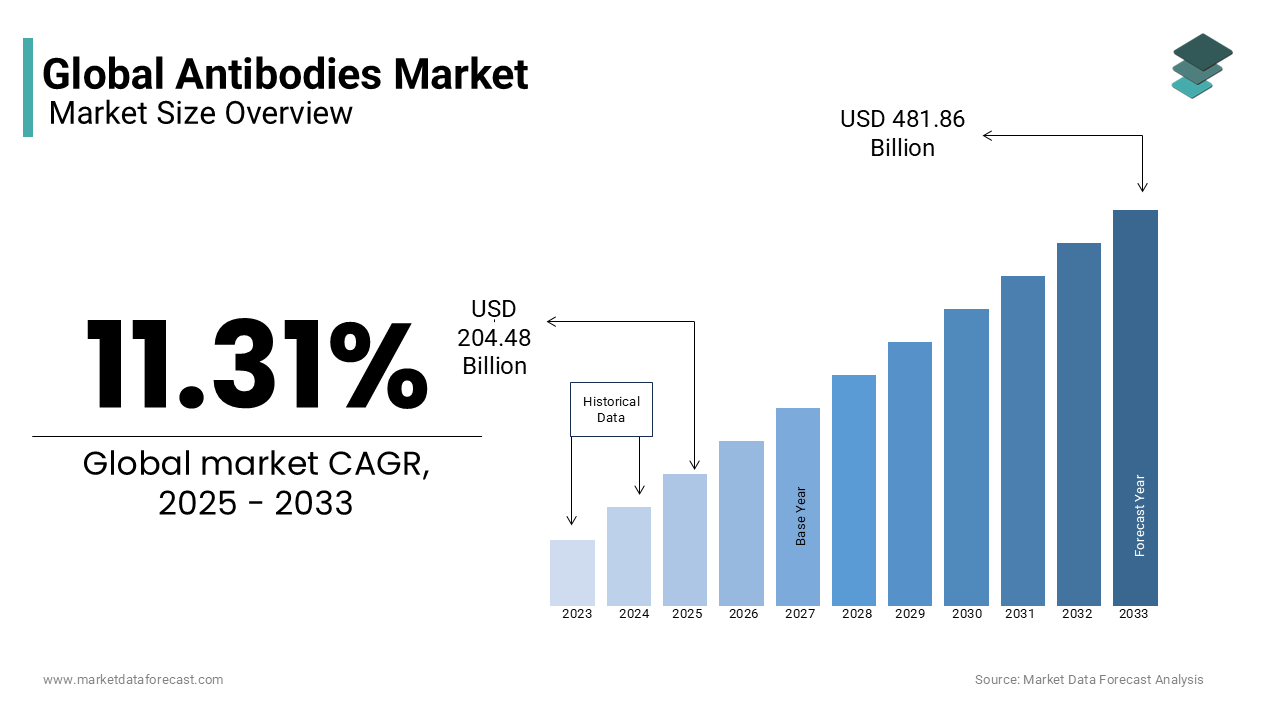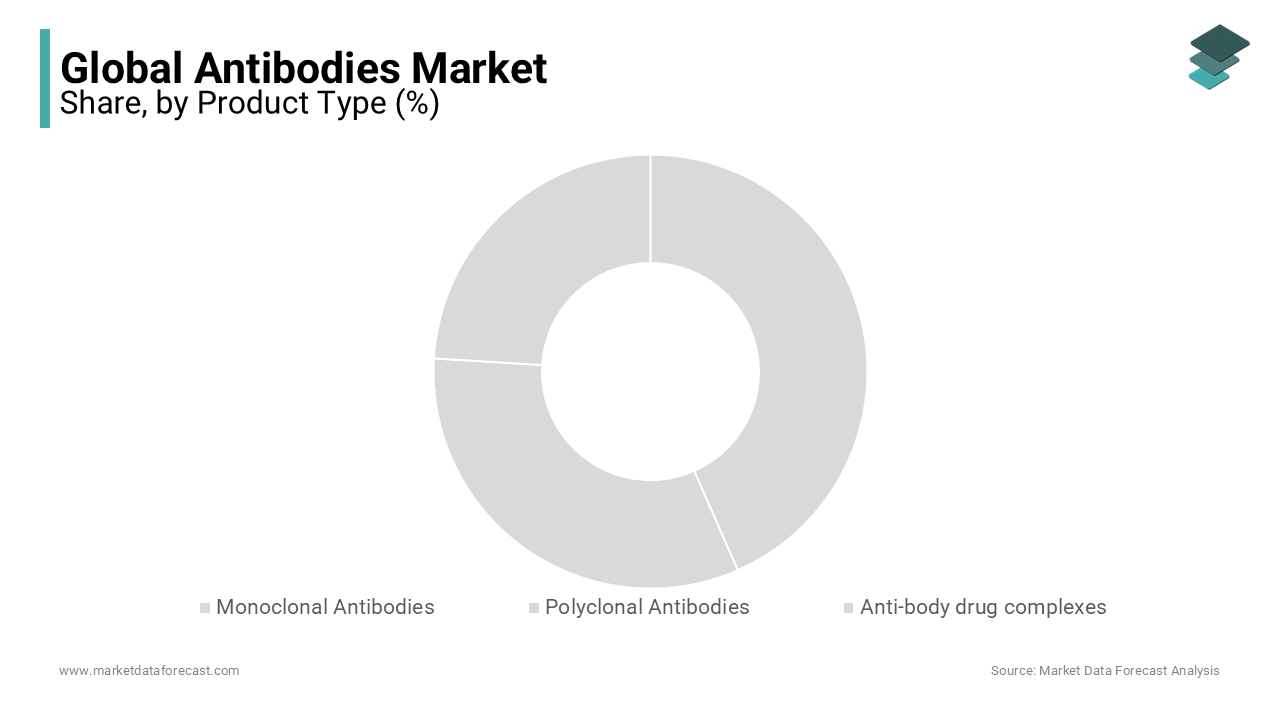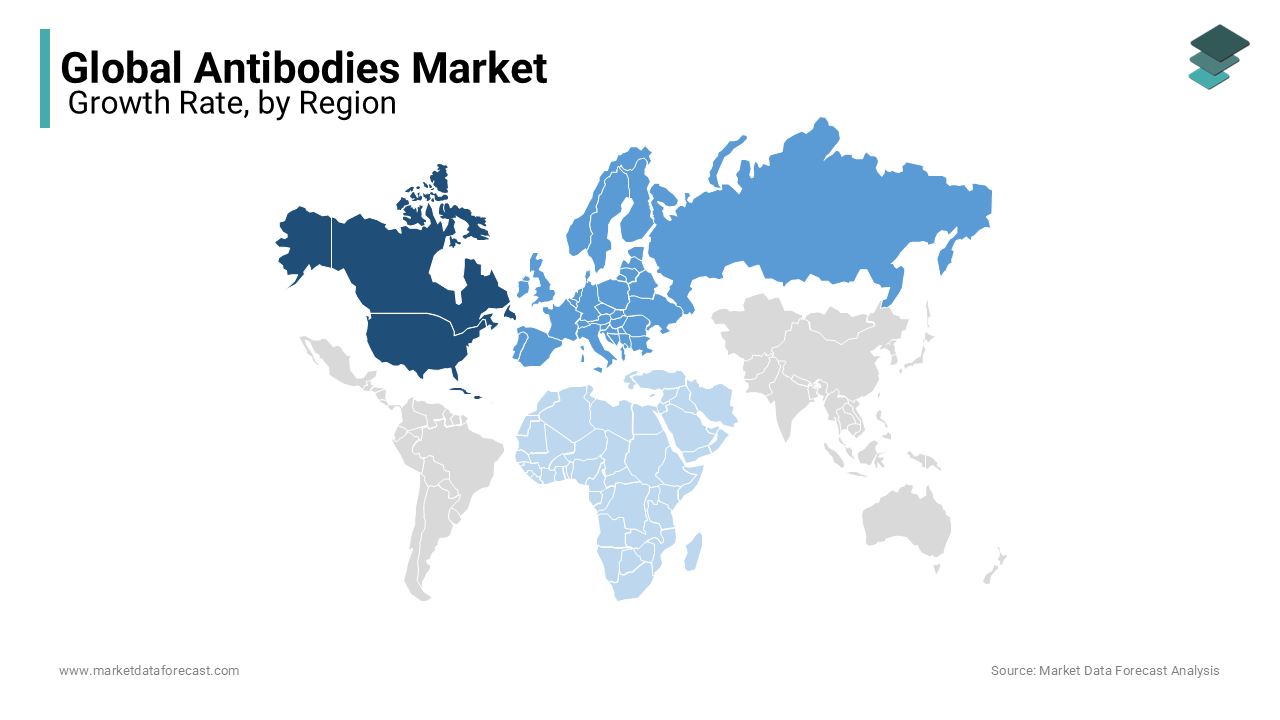Global Antibodies Market Size, Share, Trends & Growth Forecast Report – Segmented By Product Type (Monoclonal Antibodies, Polyclonal Antibodies and Anti-body Drug Complexes), Indication (Cancer, Autoimmune Diseases, Infectious Diseases, Cardiovascular Diseases, CNS Disorders and Others), End User, Application and Region (North America, Europe, Asia Pacific, Latin America, and Middle East & Africa) - Industry Analysis From 2025 to 2033
Global Antibodies Market Size
The global antibodies market size was valued at USD 183.7 billion in 2024 and is expected to reach USD 432.90 billion by 2033 from USD 204.48 billion in 2025, growing at a CAGR of 11.31 % during the forecast period.

Antibodies are proteins produced in response to specific antigens by plasma cells. They are also called immunoglobulin. These antibodies are used for diagnostics as well as therapeutic purposes for several indications of diseases, including but not limited to rheumatoid arthritis, non-Hodgkin lymphoma, psoriasis, Crohn’s disease, macular degeneration, hypercholesterolemia, and asthma. The antibodies market is projected to witness steady growth due to several product launches. In addition, effective harmonization of product development, approval, and registration guidelines in some of the major markets, such as the United States and the European Union, can speed up the research and development of antibody-related products.
MARKET DRIVERS
The growing demand for therapeutic antibodies, including monoclonal and polyclonal antibodies, is one of the key factors propelling the growth of the global antibodies market. Antibodies are also the dominant biopharmaceuticals targeting abnormal cells specifically. Therefore, many pharmaceutical and biotechnology companies have focused on developing advanced antibodies to treat chronic diseases like cancer, rheumatic heart disease, and arthritis. High drug costs, particularly biologics, are becoming increasingly important in managing healthcare costs. With increasing healthcare spending, the economic burden of cancer and other chronic diseases is growing. Improvements in the production of therapeutic antibodies have reduced the cost of manufacturing, and therefore, the penetration of antibodies has increased in cost-sensitive markets. The patent expiry of several successful monoclonal antibodies shortly is further contributing to the growth rate of the global antibodies market. In a couple of years, most antibodies like Avastin, Herceptin, and Mabthera will lose their patents. For instance, Herceptin's license (trastuzumab) expired in July 2014 in Europe and will expire in June 2019 in the United States. Many firms, including Amgen Inc., Synthon, Biocon, and Pfizer Inc., are developing a biosimilar to trastuzumab, which is expected to boost demand for products producing antibodies.
MARKET RESTRAINTS
Variations in the antibody techniques have resulted in inadequate reproductive results. No standards for their validation reproducibility across every antibody offering. The variations in the antibodies affect the results of research and clinical screening tests. The development process of monoclonal antibodies is a time-consuming and complicated procedure. One of the main concerns is that technologies require large bioreactors and filtration systems for antibody production, which is expected to impede global antibody market growth.
REPORT COVERAGE
|
REPORT METRIC |
DETAILS |
|
Market Size Available |
2023 to 2032 |
|
Base Year |
2023 |
|
Forecast Period |
2024 to 2032 |
|
Segments Analysed |
By Product Type, Indication, End User, Application, and Region |
|
Various Analyses Covered |
Global, Regional & Country Level Analysis, Segment-Level Analysis, Drivers, Restraints, Opportunities Challenges; PESTLE Analysis; Porter’s Five Forces Analysis, Competitive Landscape; Analyst Overview of Investment Opportunities |
|
Regions Analysed |
North America, Europe, Asia Pacific, Latin America, the Middle East, and Africa |
|
Market Leaders Profiled |
Abbott Diagnostics, Novartis AG, Pfizer Inc., Thermo Fisher Scientific Inc., Eli Lilly and Company, A.G. Scientific, Inc., Bristol-Myers Squibb, AbbVie Inc., and F. Hoffmann-La Roche Ltd. |
SEGMENTAL ANALYSIS
By Product Type Insights

Based on the product type, the monoclonal antibodies segment is projected to to dominate the global antibodies market during the forecast period. Monoclonal antibodies are laboratory-made proteins that boost the immune system to fight against harmful pathogens such as viruses. Therefore, the monoclonal market is anticipated to hold the largest market share in the coming years.
By Indication Insights
Based on the indication, the cancer segment accounts for the leading share during the forecast period. Over the years, cancer diseases have increased due to the uncontrollable growth of abnormal cells in the body. This factor is propelling the cancer indication segment to the extent. On the other hand, the autoimmune diseases segment is anticipated to rule the market's growth rate in the coming years.
By End User Insights
Based on End Users, the Cancer indication type segment is predicted to account for the highest market share over the forecast period due to the broad range of applications of monoclonal antibodies for the treatment of various cancers. In addition, the prevalence of cancer, the rising number of research activities on antibodies, and the improvement of healthcare infrastructure facilities drive the growth of these segments.
By Application Insights
Based on the application, the medical and experimental segments are expected to have the majority share in the market as there is an increase in the research and development activities on production of antibodies. In addition, the rising demand for antibodies in the global market is more likely to encourage the growth of these segments.
REGIONAL ANALYSIS

North America was the market's largest revenue-generating area in the last few years. Due to the presence of many other leading biopharmaceutical and biotechnology firms in this market, this region is expected to maintain its role during the forecast period. The increasing focus on biomedical, stem cell and cancer research is the primary factor influencing the growth of the North American market. Like cardiovascular and blood diseases, the rising prevalence of chronic diseases is expected to drive market growth during the forecast period. American Cancer Society estimates that 1,735,350 people have been diagnosed with chronic diseases recently. The rising number of biotechnology and biopharmaceutical companies adopting advanced research antibodies and products to examine stem cells is more likely to accelerate the market.
The European market held a substantial share in the global antibodies market during the forecast period and is projected to register a promising CAGR during the forecast period. It is owing to the growing prevalence of cardiovascular diseases and blood diseases. Increasing demand for antibodies for research productivity and R&D expenditure and funding are expected to witness a steady rise in the coming years.
The Asia Pacific market is expected to be the fastest-growing regional market and was one of the largest market shareholding regions in 2019, with an increasing CAGR of the research antibodies and reagents market during the previous year. Moreover, improving healthcare infrastructure, lowering regulatory hurdles, and increasing pharmaceutical investments are projected to augment market growth.
The Latin American market is estimated to hike at a steady rate during the forecast period. Government investments in improving healthcare infrastructure are projected to drive market growth over the forecast period.
The Middle East Africa market had a smaller global market share but was estimated to register a healthy CAGR during the forecast period. Substantial increases in research and development activities to develop effective diagnostic therapy and an increasing number of research activities are projected to propel the growth of the antibody market in this region.
KEY MARKET PLAYERS
Notable companies profiled in the report leading the global antibodies market are Abbott Diagnostics, Novartis AG, Pfizer Inc., Thermo Fisher Scientific Inc., Eli Lilly and Company, A.G. Scientific, Inc., Bristol-Myers Squibb, AbbVie Inc., and F. Hoffmann-La Roche Ltd.
RECENT MARKET DEVELOPMENTS
- In April 2016, the U.S. approved ERELZI-Novartis biosimilar to Enbrel. The European Union subsequently approved ERELZI in April 2017. With this authorization, Novartis opened an enormous market opportunity for R.A. in 28 E.U. member states.
MARKET SEGMENTATION
This research report on the global antibodies market has been segmented based on the product type, indication, end-user, application, and region.
By Product Type
- Monoclonal Antibodies
- Murine
- Chimeric
- Humanized
- Human
- Polyclonal Antibodies
- Type I
- Type II
- Type III
- Type IV
- Type V
- Type VI
- Type VII
- Type VIII
- Anti-body drug complexes
- Immunogen Technology
- Seattle Genetics Technology
- Immunomedics Technology
By Indication
- Cancer
- Autoimmune Diseases
- Infectious Diseases
- Cardiovascular Diseases
- CNS Disorders
- Others (Inflammatory, Microbial Diseases, & Others)
By End User
- Hospitals/Clinics
- Research Institute
- Diagnostics laboratories
By Application
- Medical
- Experimental
- Western blot
- ELISA
- Radioimmune Assays
- Immunofluorescence
- Others (Immunohistochemistry, Immunoprecipitation, & Immunocytochemistry)
By Region
- North America
- Europe
- Asia-Pacific
- Latin America
- The Middle East and Africa
Frequently Asked Questions
How much is the global Antibodies Market going to be worth by 2033?
As per our research report, the global Antibodies Market size is projected to be USD 481.86 billion by 2033.
At What CAGR, the global Antibodies Market is expected to grow from 2025 to 2033?
The global Antibodies Market is estimated to grow at a CAGR of 11.31% from 2025 to 2033.
Which region is anticipated to witness considerable growth in the Antibodies Market?
Geographically, the APAC Antibodies Market is predicted to have the fastest growth rate in the global market from 2025 to 2033.
Who are the leading players in the Antibodies Market?
Abbott Diagnostics, Novartis AG, Pfizer Inc., Thermo Fisher Scientific Inc., Eli Lilly and Company, A.G. Scientific, Inc., Bristol-Myers Squibb, AbbVie Inc. are some of the leading players in the Antibodies Market.
Related Reports
Access the study in MULTIPLE FORMATS
Purchase options starting from
$ 2500
Didn’t find what you’re looking for?
TALK TO OUR ANALYST TEAM
Need something within your budget?
NO WORRIES! WE GOT YOU COVERED!
Call us on: +1 888 702 9696 (U.S Toll Free)
Write to us: sales@marketdataforecast.com
